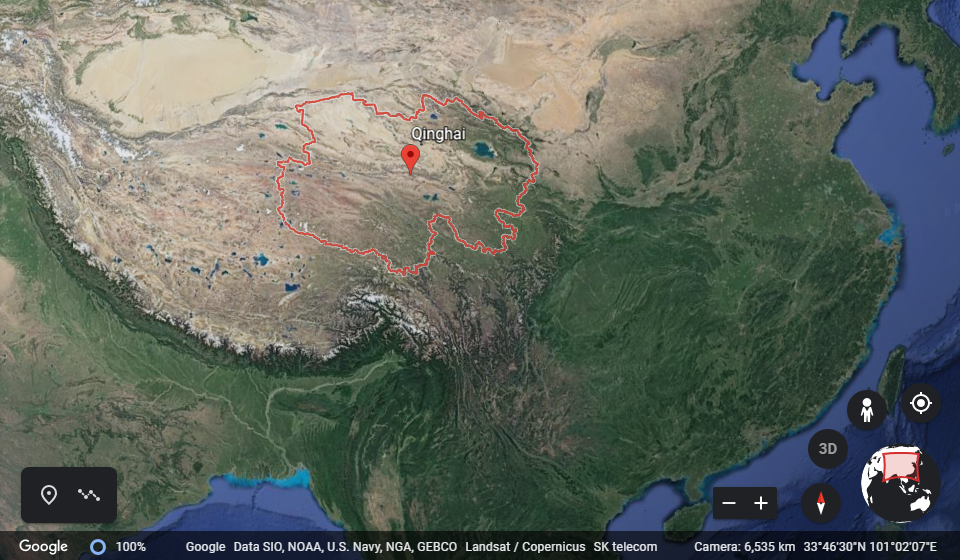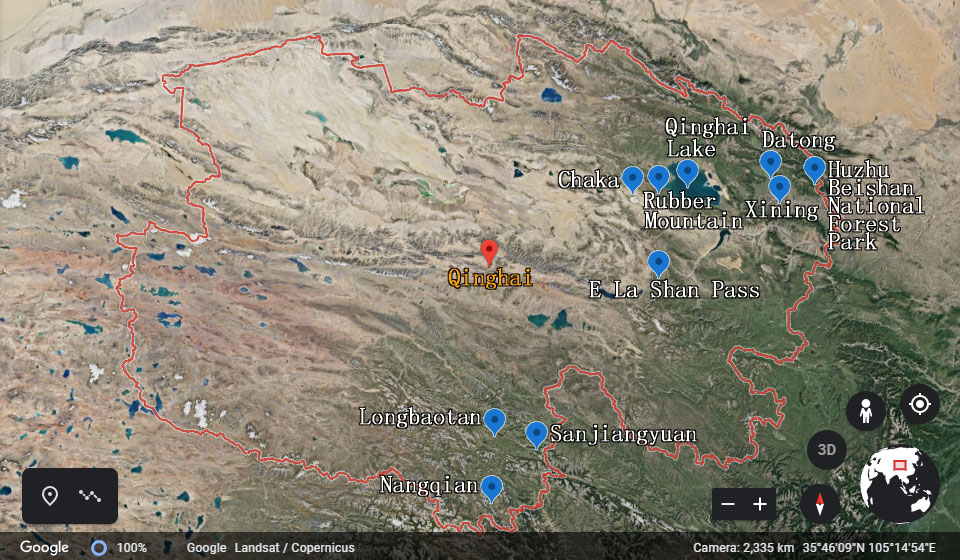Birding info of Qinghai, China

Located in the northeast part of Qinghai-Tibet Plateau, Qinghai province covers 722,300 square kilometers of land territory. The capital is Xining, which has a history of 900 years. As an important part of the “Roof of the World”, Qinghai enjoys a typical plateau continental climate featuring dry air, sparse rain, heavy winds, and plenty sunshine. The northeast part of the province is Altun Mountain Ranges and Qilian Mountain Ranges, the northwest is the Qaidam Basin, and the south part is the Tibet Plateau which occupies the half of the total area of Qinghai. The average elevation of Qinghai province is over 3,000 meters above sea level, the world-famous Qinghai-Tibet Railway go through its western part and is the highest railway in the world.
Almost all the major rivers in China starts from Qinghai Province. The Yellow River originates in the southern part of the province, while the Yangtze and Lancang (Mekong) Rivers have their sources in the southwestern part. There are 266 lakes scatters in different parts of the province. Among them, Qinghai Lake is the largest lake in China. Vast territory with sparse people provides an excellent environment for wildlife of which 68 species are under national key protection. We can expect some unique plateau wildlife such as Tibetan Antelope, Tibetan Gazelle, White-lipped Deer, Przewalski’s Gazelle, Goitered Gazelle, Wolf, Eurasian Lynx, Blue Sheep, Argali, Tibetan Woolly Hare, Himalayan Marmot, Black-lipped Pika, Wild Yak, Kiang, etc.
The province has recorded 339 bird species, including the rare species Black-necked Crane, Tibetan Bunting, Tibetan Rosefinches Tibetan Sandgrouse, Tibetan Babax, and Pink-tailed Bunting. Other birds like Buff-throated Monal Partridge, Severtzov's Grouse, Tibetan Snowcock, Przevalski's Partridge, Tibetan Partridge, Blood Pheasant, White Eared Pheasant, Blue Eared Pheasant, Whooper Swan, Black Stork, Lammergeier, Golden Eagle, Himalayan Buzzard, Ibisbill, Eurasian Eagle-Owl, Black Woodpecker, Amur Falcon, Eurasian Hobby, Saker Falcon, Isabelline Shrike, Chinese Grey Shrike, Mongolian Ground Jay, White-browed Tit, Ground Tit, Mongolian Lark, Tibetan Lark, Hume's Short-toed Lark, Asian Short-toed Lark, Horned Lark, White-browed Tit Warbler, Crested Tit Warbler, Smoky Warbler, Alpine Leaf Warbler, Gansu Leaf Warbler, Chinese Leaf Warbler, Sichuan Leaf Warbler, Chinese Nuthatch, Przevalski's Nuthatch, White-backed Thrush, Chinese Thrush, Chinese Rubythroat, Siberian Rubythroat, Ala Shan Redstart, Hodgson's Redstart, Isabelline Wheatear, Desert Wheatear, Tibetan Snowfinch, Père David's Snowfinch, Blanford's Snowfinch, Alpine Accentor, Robin Accentor, Brown Accentor, White-winged Grosbeak, Mongolian Finch, Black-headed Mountain Finch, Streaked Rosefinch, Pale Rosefinch, Chinese White-browed Rosefinch, etc.
Some Important Birding Sites in Qinghai

Qinghai Lake Area
Qinghai Lake is the largest lake in China that characterized by its gorgeous sceneries. The vast grassland and numerous wetlands and ponds around this immense lake make it an important breeding habitat for birds of Asia. The various habitat holds a great number of migratory and resident birds including some plateau specials such as Black-necked Crane, the only crane species breeds on the plateau. Other sought-after species you can expect including Bar-headed Goose, Northern Pintail, Red-crested Pochard, Eurasian Wigeon, Whooper Swan, Ferruginous Duck, Ruddy Shelduck, Tufted Duck, Black-necked Grebe, Great Crested Grebe, Little Grebe, Pallas's Gull, Kentish Plover, Pale Martin, Green Sandpiper, Common Redshank, Twite, Hume's Short-toed Lark, Asia Short-toed Lark, Mongolian Lark, Tibetan Lark, Rufous-necked Snowfinch, Pere David's Snowfinch, Isabelline Wheatear, Ground Tit, etc.
Rubber Mountain
The mixed shrubs and meadows in Rubber Mountain are perfect hides for the Pink-tailed Bunting (Przewalski's Finch), which is a bird in a family all of its own. There are many other exciting bird species that hide in the scrubs on the mountain slopes such as the shy Tibetan Partridge, Saker Falcon, Streaked Rosefinch, Chinese White-browed Rosefinch, Tibetan Snowfinch, White-rumped Snowfinch, Rufous-necked Snowfinch, Rufous-breasted Accentor, Brown Accentor, Robin Accentor, White-browed Tit, Ground Tit, Himalayan Griffon, Upland Buzzard, etc.
Nangqian (Kanda Mountain, Baizha Forest Management Area)
To the west of Yushu, where rugged and grand valleys come into view, there is a fantastic birding site, Kanda Mountain, which holds abundant birding resources especially some specials inhabits in the eastern of the Qinghai-Tibet Plateau, for example, the three range-limited endemic species, namely the Buff-throated Partridge (Szechenyi's Monal Partridge), Tibetan Bunting, and Tibetan Babax. Besides, you can expect some exciting species like Tibetan Bunting, Tibetan Babax, Tibetan Partridge, White Eared Pheasant, Snow Pigeon, while other birds like Hill Pigeon, Red-billed Chough, Grey-backed Shrike, Elliot's Laughingthrush, Kessler's Thrush(White-backed Thrush), Blue-fronted Redstart, Hodgson's Redstart, Yellow-streaked Warbler, Pink-rumped Rosefinch, Chinese White-browed Rosefinch, and Godlewski's Bunting. You may seek out an important summer breeder, the Ibisbill in the river shoals.
Baizha Forest is another well-forested mountain area in Nangqian. During the golden morning hours, you can focus on tracking pheasants preferentially. Besides the endemic Buff-throated Partridge (Szechenyi's Monal-Partridge), the White Eared Pheasant, Blood Pheasant, Tibetan Snowcock and Tibetan Partridge also inhabit in this area. Other species you can expect in this area are the Tibetan Babax, Hill Pigeon, Salim Ali's Swift, Three-toed Woodpecker, Black Woodpecker, Pink-rumped Rosefinch, Red-fronted Rosefinch, Rufous-vented Tit, Sichuan Tit, Crested Tit Warbler, White-browed Tit Warbler, Sichuan Leaf Warbler, Greenish Warbler, Chinese Rubythroat, Lammergeier (Bearded Vulture), Golden Eagle, Daurian Jackdaw, Alpine Chough, White-throated Dipper, and White-winged Grosbeak.
Datong
Dongxia Forest Park is about a 1.5-hour drive from Xining. The evergreen conifer woods are the dominant tree species in the forest, and lush shrubs occupy the forest gaps and openings, both provide great habitats for small forest species including nuthatches, warblers, tits, etc. You can seek out some exciting species such as the Crested Tit Warbler, White-browed Tit Warbler, Gansu Leaf Warbler, Chinese Nuthatch (Snowy-browed Nuthatch), Przewalski's Nuthatch (White-cheeked Nuthatch), Plain Laughingthrush, Elliot's Laughingthrush, Siberian Rubythroat, and Chinese Thrush. The dense forest is also home to other noteworthy species like Daurian Jackdaw, Rook, Kessler's Thrush, Chestnut Thrush, Common Rosefinch, Chinese White-browed Rosefinch, Grey-headed Bullfinch, Grey-capped Greenfinch, Red Crossbill, Slaty-backed Flycatcher, White-throated Redstart, Rufous-vented Tit, as well as the shy Smoky Warbler.
Huzhu Beishan National Forest Park
Huzhu Beishan located on the eastern edge of the Qilian Mountain, it is also a geopark. There are two superb Chinese endemic bird species, the magnificent Blue Eared Pheasant and the somewhat elusive Chinese Grouse (Severtzov's Grouse), which generally feed on the openings around the forest line in the early morning. In the lower forest area, there are some other exotic birds such as Crested Tit Warbler, Himalayan Bluetail, Chestnut Thrush, Common Rosefinch, Pink-rumped Rosefinch, Grey-headed Bullfinch, Goldcrest, Rufous-breasted Accentor, White-winged Grosbeak, Spotted Bush Warbler, Large-billed Warbler, Greenish Warbler, Chinese Leaf Warbler, etc. With some luck, you may spot Wallcreeper, Eurasian Eagle-Owl on the cliffs, and in rock crags. In addition, it is also a good idea to search the stream at the bottom of the mountain for some come water birds including White-throated Dipper, White-capped Water Redstart, Plumbeous Water Redstart, etc.
E La Shan Pass
E La Mountain is a sub-branch of the majestic Kunlun Mountain Ranges. At the pass, the highway climbs to nearly 4,500m where the road is surrounded by snow-capped peaks that stretch away toward the distant horizon. Here is the place to search for Tibetan Sandgrouse and Tibetan Rosefinch. In this area, you can also spot other birds like White-winged Redstart, Shore Lark, Tibetan Lark, Black Redstart, Black-winged Snowfinch, White-rumped Snowfinch, Rufous-necked Snowfinch, Plain Mountain Finch, Black-headed Mountain Finch, etc.
Chaka (Chaka Salt Lake)
Chaka is occupied by harsh deserts and arid mountain ranges where inhabited some unique plateau and desert species. Some of these birds require a level of patience as they are well-adapted to staying hidden in this vast ecosystem, but these birds are well worth the effort. For instance, the Pallas's Sandgrouse is a gorgeous desert species and is adept at camouflaging itself in the ochre desert steppe. Other sought-after species you may encounter including Henderson's Ground Jay, Isabelline Shrike, Isabelline Wheatear, Desert Wheatear, Crested Lark, Asian Short-toed Lark, Hume's Short-toed Lark, Mongolian Finch, Pere David's Snowfinch and Blanford's Snowfinch. In the forest bordering the nearby villages, we will focus on some arboreal species such as Eurasian Golden Oriole, Great Spotted Woodpecker, White-cheeked Starling, Eurasian Hoopoe, Azure-winged Magpie, Upland Buzzard, Amur Falcon, etc. Additionally, you can plan some time on searching the nearby valleys of bush fallows and meadows to search for birds like the rare and elusive Przevalski's(Ala Shan) Redstart, Rusty-necklaced(Przevalski's) Partridge, Tibetan Partridge, Hill Pigeon, Black Redstart, Pine Bunting, etc.
Longbaotan Nature Reserve
Established in 1986, Longbaotan Nature Reserve located in Yushu Autonomous Prefecture. It has typical alpine meadows and marsh wetlands 4,100~4,200 meters above sea level. It is the home for Black-necked Cranes and other 52 bird species which have been recorded. Many rare species breed here during spring and summer every year including Black stork, Lammergeier, and White-tailed Eagle.
Sanjiangyuan Nature Reserve
Located in the hinterland of the Qinghai-Tibet Plateau and the south of Qinghai province, Sanjiangyuan is a habitat unlike any other. It is China’s largest natural reserve which the total 363,000 square kilometers of this reserve makes up roughly 50.4% of Qinghai province, and it is the birthplace of China’s Yangtze, Yellow and Lancang rivers. It has the typical alpine characteristics of the ecosystem and biodiversity found throughout the Qinghai-Tibet Plateau. The flora, fauna, and wetland ecosystem in this region are distinctly unique while its natural ecosystem remains in its original state.
In total, Sanjiangyuan is home to 85 species of mammals, 237 species of birds, and 48 species of amphibians. There are 16 nationally protected (class I) animals including Tibetan Antelope, Wild Yak, Tibetan Wild Ass, Snow Leopard, Leopard, White-lipped Deer, Black-necked Crane, Golden Eagle, Pallas’s Fish Eagle, and Bearded Vulture. Additionally, there are 53 nationally protected (class II) species such as Argali, Tibetan Gazelle, Sumatran Serow, Rhesus Macaque, Asiatic Black Bear, Himalayan Musk Deer Red Deer, Himalayan Brown Bear, Lynx, Saker Falcon, Cinereous Vulture, and so on. There are 32 provincial protection species like Steppe Polecat, Corsac Fox, Yellow Weasel, Bar-headed Goose, Ruddy Shelduck, etc. For naturalists looking to find a plethora of China’s most coveted animal species, Sanjiangyuan is the ideal destination.
Last one: Birding info of Ningxia, China
Next one: Birding info of Shaanxi, China







